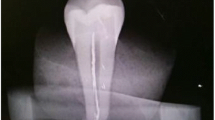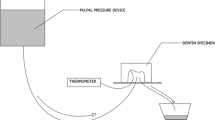Abstract
It is suggested that pulpal fluid circulation has an impact on pulp temperature increase during heat-generating dental treatment procedures. Thus, the aim of the study was to assess the effect of a simulated pulpal fluid circulation on temperature changes inside the pulp chamber following laser irradiation of the tooth surface. Twenty freshly extracted human multirooted teeth were included and cross-sectioned along the long axis exposing two root canals each. The pulp chamber and root canals were cleaned from remaining soft tissues to achieve access for a temperature sensor and two cannulas to allow fluid circulation. Cross sections were glued together, and the roots were encased with silicone impression material to ensure the position of the connected devices. Each tooth was irradiated by employing a neodymium-doped yttrium orthovanadate (Nd:YVO4) laser at 1,064 nm with a pulse duration of 9 ps and a repetition rate of 500 kHz. A commercially available scanning system (SCANcube 7, SCANLAB) deflected the beam by providing rectangular irradiated areas of 0.5 mm edge length. Measurements were performed with four different settings for fluid circulation: without any water and with water (23 °C) at a flow rate of 6, 3, and 0 ml/min. The primary outcome measure was the maximum temperature difference (ΔT) after laser irradiation. Highest temperature changes (median 3.6 K, range 0.5–7.1 K) could be observed without any fluid inside the pulp chamber. Water without circulation decreased ΔT values statistically significantly (median 1.4 K, range 0.2–4.9 K) (p < 0.05). Lowest temperature changes could be observed with a water flow rate of 6 ml/min (median 0.8 K, range 0.2–3.7 K) (p < 0.05). Pulpal fluid circulation has a cooling effect on temperature increase caused by laser irradiation of dental hard tissues. Studies on heat generation during dental treatment procedures should include this aspect to assess a potential thermal injury of pulp tissue.


Similar content being viewed by others
References
O’Leary JM, Barnett TP, Parkin TD, Dixon PM, Barakzai SZ (2013) Pulpar temperature changes during mechanical reduction of equine cheek teeth: comparison of different motorised dental instruments, duration of treatments and use of water cooling. Equine Vet J 45:355–360
Cavalcanti BN, Lage-Marques JL, Rode SM (2003) Pulpal temperature increases with Er:YAG laser and high-speed handpieces. J Prosthet Dent 90:447–451
Zach L, Cohen G (1965) Pulp response to externally applied heat. Oral Surg Oral Med Oral Pathol 19:515–530
Pohto M, Scheinin A (1958) Microscopic observations on living dental pulp, part 2. The effect of thermal irritants on the circulation of the pulp in the lower rat incisor. Acta Odontol Scand 16:315–327
Anic I, Vidovic D, Luic M, Tudja M (1992) Laser induced molar tooth pulp chamber temperature changes. Caries Res 26:165–169
Gow AM, McDonald AV, Pearson GJ, Setchell DJ (1999) An in vitro investigation of the temperature rises produced in dentine by Nd:YAG laser light with and without water-cooling. Eur J Prosthodont Restor Dent 7:71–77
Konorov SO, Mitrokhin VP, Fedotov AB, Sidorov-Biryukov DA, Beloglazov VI, Skibina NB, Shcherbakov AV, Wintner E, Scalora M, Zheltikov AM (2004) Laser ablation of dental tissues with picosecond pulses of 1.06-microm radiation transmitted through a hollow-core photonic-crystal fiber. Appl Opt 43:2251–2256
Niemz MH (1994) Investigation and spectral analysis of the plasma-induced ablation mechanism of dental hydroxyapatite. Appl Phys B 58:273–281
Niemz MH (1998) Laser-tissue interactions: fundamentals and applications. Springer, Berlin
Bello-Silva MS, Wehner M, de Paula EC, Lampert F, Poprawe R, Hermans M, Esteves-Oliveira M (2012) Precise ablation of dental hard tissues with ultra-short pulsed lasers. Preliminary exploratory investigation on adequate laser parameters. Lasers Med Sci 28:171–184
Braun A., Krillke RF, Frentzen M, Bourauel C, Stark H, Schelle F (2013) Heat generation caused by ablation of dental hard tissues with an ultrashort pulse laser (USPL) system. Lasers Med Sci 2013 May 12 [Epub ahead of print]
Braun A, Wehry RJ, Brede O, Dehn C, Frentzen M, Schelle F (2012) Heat generation caused by ablation of restorative materials with an ultrashort pulse laser (USPL) system. Lasers Med Sci 27:297–303
Kodonas K, Gogos C, Tziafa C (2009) Effect of simulated pulpal microcirculation on intrachamber temperature changes following application of various curing units on tooth surface. J Dent 37:485–490
Kodonas K, Gogos C, Tziafa C (2009) Effect of simulated pulpal microcirculation on intrapulpal temperature changes following application of heat on tooth surfaces. Int Endod J 42:247–252
Cohen J (1988) Statistical power analysis for the behavioral sciences, 2nd edn. Lawrence Erlbaum, Hillsdale
Al-Qudah AA, Mitchell CA, Biagioni PA, Hussey DL (2005) Thermographic investigation of contemporary resin-containing dental materials. J Dent 33:593–602
Méndez JD, Zarzoza E (1999) Rapid determination of dry weight in human dental pulp by a colorimetric reaction. J Endod 25:596–598
Matthews B, Andrew D (1995) Microvascular architecture and exchange in teeth. Microcirculation 2:305–313
Meyer MW (1993) Pulpal blood flow: use of radio-labelled microspheres. Int Endod J 26:6–7
Seltzer S, Bender IB (1984) The dental pulp: biologic considerations in dental procedures. Lippincott, Philadelphia
Lizarelli RF, Kurachi C, Misoguti L, Bagnato VS (1999) Characterization of enamel and dentin response to Nd:YAG picosecond laser ablation. J Clin Laser Med Surg 17:127–131
Lizarelli RF, Moriyama LT, Bagnato VS (2006) Temperature response in the pulpal chamber of primary human teeth exposed to Nd:YAG laser using a picosecond pulsed regime. Photomed Laser Surg 24:610–615
Nguyen D, Chang K, Hedayatollahnajafi S, Staninec M, Chan K, Lee R, Fried D (2011) High-speed scanning ablation of dental hard tissues with a λ = 9.3 μm CO2 laser: adhesion, mechanical strength, heat accumulation, and peripheral thermal damage. j Biomed Opt 16:071410
Coutinho DS, Silveira L Jr, Nicolau RA, Zanin F, Brugnera A Jr (2009) Comparison of temperature increase in in vitro human tooth pulp by different light sources in the dental whitening process. Lasers Med Sci 24:179–185
Kilinc E, Roshkind DM, Antonson SA, Antonson DE, Hardigan PC, Siegel SC, Thomas JW (2009) Thermal safety of Er:YAG and Er,Cr:YSGG lasers in hard tissue removal. Photomed Laser Surg 27:565–570
Acknowledgments
This investigation was supported by the Federal Ministry of Education and Research, Germany (No. 13N10190)
Author information
Authors and Affiliations
Corresponding author
Rights and permissions
About this article
Cite this article
Braun, A., Kecsmar, S., Krause, F. et al. Effect of simulated pulpal fluid circulation on intrapulpal temperature following irradiation with an Nd:YVO4 laser. Lasers Med Sci 30, 1197–1202 (2015). https://doi.org/10.1007/s10103-014-1540-5
Received:
Accepted:
Published:
Issue Date:
DOI: https://doi.org/10.1007/s10103-014-1540-5




